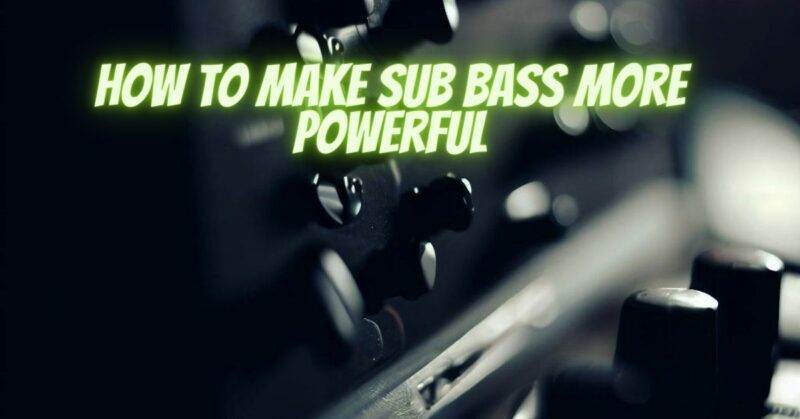Sub bass is the foundation of many music genres, providing that deep, resonant thump that moves listeners both physically and emotionally. However, achieving a powerful sub bass presence requires more than just turning up the volume. In this article, we’ll explore effective techniques for making your sub bass more powerful, ensuring it not only rumbles but also leaves a lasting impact on your audience.
1. Choose the Right Sound Source
The journey to powerful sub bass begins with selecting the right sound source. Whether you’re using synthesizers, samplers, or recordings, choose a sound that has a strong and clean sub-bass component. Sub-bass sounds generated by synthesizers or bass guitars often work well due to their pure, low-frequency content.
2. Focus on the Fundamental Frequency
The fundamental frequency of the sub bass is the heart of its power. This is the lowest, most prominent frequency in the sound. To make it more powerful, ensure that this fundamental frequency is clear and well-defined. Use an equalizer (EQ) to cut any unwanted frequencies that may clutter the mix, emphasizing the pure sub-bass tone.
3. Layer Your Sub Bass
Layering involves combining multiple sub-bass sounds to create a richer and more powerful sonic texture. This can be achieved by using different sound sources or duplicating your sub-bass track and processing each layer separately. Experiment with layering to find the right balance and character for your sub bass.
4. Add Harmonic Saturation
Saturation plugins or hardware can add harmonics to your sub bass, making it more audible on smaller speakers and adding warmth and character. Be cautious not to overdo it, as excessive saturation can lead to distortion. Start with subtle saturation and adjust to taste.
5. Use Sidechain Compression
Sidechain compression is a technique where the sub bass is ducked (reduced in volume) whenever the kick drum hits. This creates space for the kick drum’s transient to punch through, enhancing the overall impact of the low end. Sidechain compression is a common technique in electronic dance music (EDM) and hip-hop.
6. Pay Attention to Timing and Rhythm
The timing and rhythm of your sub bass notes are crucial for creating a powerful groove. Ensure that your sub bass is tightly synchronized with the rest of the track, especially the kick drum. The rhythmic interplay between the sub bass and kick drum can greatly affect the perceived power of the low end.
7. Monitor and Test on Different Systems
A powerful sub bass should translate well across various listening systems, from high-end studio monitors to consumer headphones and car stereos. Regularly check your mix on different playback devices to ensure that the sub bass retains its impact and clarity.
8. Use Low-Frequency Effects (LFE) Channels
In audio production for film and video, there’s often a dedicated Low-Frequency Effects (LFE) channel for sub bass content. Utilize this channel to send low-frequency information to a subwoofer or specialized speakers, enhancing the overall power and impact of sub bass in cinematic contexts.
9. Mastering Considerations
When mastering your music, work with a skilled mastering engineer who understands the nuances of sub bass. They can apply specialized techniques to ensure that the sub bass is powerful and balanced in the final mix.
Making sub bass more powerful is a combination of selecting the right sound source, shaping its frequency content, and carefully integrating it into your mix. By following these techniques and paying attention to detail, you can achieve sub bass that not only rumbles but also resonates with your audience, adding depth and impact to your music.


